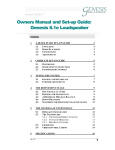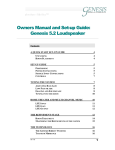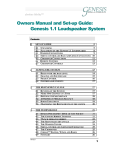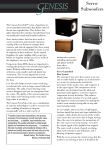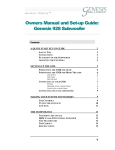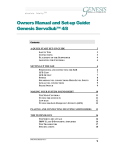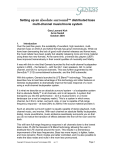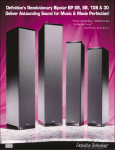Download Genesis Advanced Technologies G6.1c User's Manual
Transcript
~ÄëçäìíÉ=ÑáÇÉäáíó Owners Manual and Set-up Guide: Genesis 6.1 Center Channel Loudspeaker Contents 1 2 A QUICK START SET-UP GUIDE 4 1.1 1.2 1.3 1.4 4 4 5 5 SETTING UP: MULTI-CHANNEL 2.1 2.2 3 3.3 3.4 3.5 3.6 3.7 3.8 ver 1.0 POSITIONING FOR CENTER CHANNEL LOUDSPEAKER CONTROLS 2.2.1 TWEETER AND MIDRANGE CONTROLS 2.2.2 TWEETER DEFEAT SETTING UP AS STEREO PAIR 3.1 3.2 4 UNPACKING PLACEMENT CONNECTIONS ADJUSTMENTS POSITIONING LOUDSPEAKER CONTROLS 3.2.1 TWEETER AND MIDRANGE CONTROLS 3.2.2 TWEETER DEFEAT TUNING THE SYSTEM ONE CHANGE AT A TIME IMAGING AND SOUNDSTAGE DEFINING THE SOUNDSTAGE ROOM TREATMENT MASTERING THE REFINEMENTS OF THE SYSTEM 6 6 6 6 7 8 8 8 8 9 9 10 10 11 12 13 THE TECHNOLOGY USED 14 4.1 4.2 14 14 14 DIPOLAR CONFIGURATION THE TRANSDUCERS 4.2.1 THE GENESIS RIBBON TWEETER 1 ~ÄëçäìíÉ=ÑáÇÉäáíó 4.3 4.4 5 ver 1.0 4.2.2 TITANIUM MIDRANGE 4.2.3 ALUMINUM-CONE WOOFERS CROSSOVER VIBRATION-FREE CABINET SPECIFICATIONS 15 15 15 16 17 2 ~ÄëçäìíÉ=ÑáÇÉäáíó A Message from Genesis Congratulations! You are now the owner of one of the finest loudspeakers in the world. Based on technologies developed for our flagship Genesis 1, the Genesis 6.1 Center Channel (G6.1c) is designed for those of us who live in beautiful homes and want an elegant loudspeaker that will deliver the best sound in its class. While the G6.1c is designed as a center channel speaker in a multichannel music or home theater system, it is also designed to be as flexible as possible. It can be used as a pair of audiophile stereo loudspeakers or, in a multi-channel system, can also be used as main left/right speakers, monopole surround or monopole rear channels. So that it will fit into the décor of any home, the cabinet design is a combination of acoustic, furniture, interior design and architectural principles. It is a perfect match for the elegant and beautiful Genesis 6.1 Loudspeaker system with the same look and driver complement (except for the bass drivers). Being a Genesis absolute fidelity™ product, it is also a perfect complement to any other Genesis model, all the way up to the Genesis 1.1. Sound structural engineering principles have been applied to make the G6.1c cabinet rigid and well damped. All construction and even internal braces are made of 1-inch MDF and have been “tongue and grooved” to ensure that the cabinet is the best environment on which to mount the transducers. This results in extremely low cabinet coloration, and excellent soundstaging and imaging. Please read this Owners Manual and Set-up Guide to get the maximum enjoyment out of your purchase. Also, check out our website at www.genesisloudspeakers.com for the latest updates, tips & tricks and support for our owners. Please write the serial number and purchase details of your Genesis 6.1c here for future reference. Purchased at: _________________ Date: __________ ver 1.0 3 ~ÄëçäìíÉ=ÑáÇÉäáíó 1 A Quick Start Set-up Guide Now that you have your new Genesis 6.1 Center Channel, we realize that you can’t wait to hook it up and start playing! However, please read this quick set-up guide (even if your dealer is setting it up for you) before you proceed. 1.1 Unpacking Your loudspeakers will come to you in a large shipping carton weighing over 70lbs (32kgs). We suggest that two strong people move the speaker carton around and to lift the speaker out of its carton. Even then, use correct lifting techniques. We will not be held liable for damage to either the speakers or your backs during unpacking and setting up. 1.2 Placement Used as a center channel, the G6.1c can be placed below or above your screen. If you have a perforated, sonically transparent projector screen, you may place it behind the screen. In all cases, do not point the tweeter directly at the ears of the listeners. Angle the speaker so that the tweeter points 12 inches (30cm) below the ears or over the top of the head. As a stereo pair of speakers, a good starting position for your G6.1c is about 18 inches (46cm) into the room as measured from the front wall (the wall you look at as you are seated listening to the speakers) to the back of the speakers. Place the speakers vertically on a stand that is at least 24 inches high, and about five feet (1.5 metres) apart with the tweeters closest together. Toe the speakers in slightly towards the listeners – by about 5 to 10 degrees – no more. You will want to sit nine to twelve feet (three to four metres) away from the speakers. When sitting further away, you should place the speakers further apart. If you are using the G6.1c as monopole surround or rear speakers, and you are hanging them on the wall, you will need a qualified installer to mount them on very strong brackets. The speakers weigh over 69 pounds (31.5kgs) each, and can cause death or severe injury if it falls on someone! ver 1.0 4 ~ÄëçäìíÉ=ÑáÇÉäáíó 1.3 Connections The speakers should be connected directly to the speaker-level output of your power amplifiers using high quality speaker cables and the 5way binding posts. The high-level thru-put binding posts are for connecting to a subwoofer. We recommend the Genesis ServoSub™ 4/8 as the perfect complement to this speaker. 1.4 Adjustments Don’t be too worried by the knobs on the back of the G6.1c. Just set both knobs to the 12 o’clock position. That is a good place to start. The G6.1c will sound great, straight out of the box, set-up like this. As you play your system for the next hundred hours or so, the speaker will settle in and break in. If you have at least 12 inches (30cm) of space between the back of the speaker and the rear wall, the rear tweeter should be left ON. Otherwise, turn the rear tweeter off with the tweeter defeat switch on the back panel. Once you familiarize yourself with its performance, putting a little bit of additional effort into tuning the speaker properly for your system (which includes the room), will give you greater long-term enjoyment and benefits. ver 1.0 5 ~ÄëçäìíÉ=ÑáÇÉäáíó 2 Setting up: Multi-channel 2.1 Positioning for Center Channel A good starting position is for the G6.1c to be placed horizontally about 20 inches from the floor, and angled upwards by 3 to 5 degrees. This is assuming that the speaker doesn’t block the screen in this position. Use a good quality stand that is solidly built and as rigid as possible. The Genesis ServoSub™ 4/8 is a unique subwoofer that complements the G6.1c to turn it into a full-range absolute fidelity™ system, and also makes a perfect stand for the G6.1c. An alternative is to place the speaker horizontally above the television set, and angle it downwards by 3 to 5 degrees. In either case, do not point the speaker directly at the head of the listener, but either over her heads, or at her chest. As these speakers are dipolar with a rear-firing tweeter, there should be at least 12 inches (30cm) of space between the back of the speaker and the wall. If this space is not available, switch the rear tweeter off with the tweeter defeat switch. On the home theatre processor, set the speaker to “LARGE” as the 6.1c plays below 60Hz. 2.2 Loudspeaker Controls 2.2.1 Tweeter and Midrange Controls The two knobs at the top of the plate on the back of the speaker tailor the mid- and high-frequency response of the G6.1c. They are subtle controls, but they can make a great difference in gaining that last bit of additional performance in tuning your speakers for the room in which you are using them. They can turn your system from very good to exceptional, so take the time to work through this process. The left knob marked TWEETER is a volume control for the front tweeter. Turning this control clockwise will increase the level of the tweeters. Use this control if you need a bit more treble, or to increase the apparent space of the soundstage. Too high a tweeter level, and you can feel that voices are too sibilant. With music, crashing cymbals are leaping out at ver 1.0 6 ~ÄëçäìíÉ=ÑáÇÉäáíó you, and nylon stringed guitars sound steely. Start with this control at the 12 o'clock position. There is about a ± one dB range for this control. The right knob marked MIDRANGE is used to adjust the level of the midrange. Start at the 12 o’clock position. Turning the control anticlockwise will make the midrange sound leaner - turning it clockwise will make the midrange sound fuller. A fuller midrange can also make voices sound more forward. There is about a ± one-and a half dB range for this control. These two controls can also be used to fine tune the speaker when it is used behind a perforated screen, which typically attenuates the mid- to high- frequency response. 2.2.2 Tweeter Defeat The G6.1c should be placed at least 12 inches (30cm) away from the wall behind the speaker. If this is not possible, turn the rear-firing tweeter off to configure your loudspeaker as a monopole. This is perfectly acceptable and will not compromise the performance for multi-channel surround movies. ver 1.0 7 ~ÄëçäìíÉ=ÑáÇÉäáíó 3 Setting up as Stereo Pair 3.1 Positioning Used as a stereo pair, the G6.1c should be placed vertically 18 inches (0.45m) into the room as measured from the front wall (the wall you look at as you are seated listening to the speakers), to the back of the speaker. They should be placed on good, solid speaker stands about 18 to 24 inches (60cm) high. You will notice that the tweeter and midrange drivers are mounted on a round plate secured with four screws. These screws can be removed, and the plate rotated by 45 degrees so that the tweeter and midrange are at an angle, or rotated by 90 degrees so that the tweeter is above the midrange. If you do rotate the midrange and tweeter, it would still be better to have the rear tweeters closest to one another. Start with the speakers five feet (1.5m) apart with the tweeters (both front and rear) placed closest together, and angled in (toed-in) towards the listener by about 5 degrees. You will want to sit 8 to 10 feet (2.4 to 3.0 metres) away from the speakers (if you have the space). We will experiment with moving the speakers around later. As these speakers are dipolar in the high frequencies, they are pretty room-friendly and you are free to move the speakers closer to, or further away from the front and side walls. We do recommend, however, that you give the speakers a little bit of breathing space behind them, so don’t push them up tight against the wall. If you have the speakers too close to the front wall, you will find that the image depth is not as good - the soundstage becomes a little twodimensional. If you have the space to move the speakers away from the wall, do so. You will be rewarded with the deep, broad soundstage that this loudspeaker is capable of. You should be able to “see” the soundstage behind, as well as in front of, the loudspeakers. The sound stage will also extend outside the left and right sides of the speakers. 3.2 Loudspeaker Controls 3.2.1 Tweeter and Midrange Controls The two knobs at the top of the plate on the back of the speaker tailor the mid- and high-frequency response of the G6.1c. They are subtle controls, but they can make a great difference in gaining that last bit of ver 1.0 8 ~ÄëçäìíÉ=ÑáÇÉäáíó additional performance in tuning your speakers for the room in which you are using them. They can turn your system from very good to exceptional, so take the time to work through this process. The left knob marked TWEETER is a volume control for the front tweeter. Turning this control clockwise will increase the level of the tweeters. Use this control if you need a bit more treble, or to increase the apparent space of the soundstage. Too high a tweeter level, and you can feel that crashing cymbals are leaping out at you, and nylon stringed guitars sound steely. Start with this control at the 12 o'clock position. There is about a ± one dB range for this control. The right knob marked MIDRANGE is used to adjust the level of the midrange. Start at the 12 o’clock position. Turning the control anticlockwise will make the midrange sound leaner - turning it clockwise will make the midrange sound fuller. A fuller midrange can also make the soundstage appear more forward. There is about a ± one and a half dB range for this control. 3.2.2 Tweeter Defeat The optimal way to use these speakers as a stereo pair is to leave the rear tweeters on, and run them as dipole and approximately 18-inches from the wall. However, in some cases, this may not be possible. Should the speakers have to be placed with their backs less than 12 inches from the wall, the rear tweeters should be turned off. 3.3 Tuning the system Music is the best way to begin your set-up procedure. We suggest that video sources be used only after you have set-up the system to properly reproduce music. There is no “perfect” setting for the G6.1c loudspeaker. Every listening room is different, and we recommend that you take the time to carefully tune the system for the environment in which it is placed. Setting all the knobs at the “12 o’clock” position is “normal” and will be the position from which you can start tuning. With the controls in this ver 1.0 9 ~ÄëçäìíÉ=ÑáÇÉäáíó position, they may not sound perfect, but your Genesis loudspeakers will sound great straight out of the box. 3.4 One Change at a Time One rule of thumb you should always keep in mind: Make one change at a time! Do not, for instance, change position of the speakers and make an adjustment to the amplifier all at once. Make each of these changes separately and note the difference - by listening with each adjustment - then make the next change. 3.5 Imaging and Soundstage We suggest that you start with a single vocal with simple instrumental accompaniment because the sound of the human voice is more easily recognizable than many instruments and is a less complex sound to deal with. Use a good recording that you know has atmosphere and low bass content. The performer should appear to be positioned behind the loudspeakers and be at the appropriate height for a standing person. If it is not, there are several remedies that will address this shortfall: If the vocal appears to be larger than life, you should first check the system volume. Is it a volume that would be appropriate for someone actually singing in your room? If there is too much volume the artist will appear too big and the opposite is true for too little volume. If the volume is set correctly and the image is still too big, place the speakers closer together and re-listen. Place the speakers no less than 5 feet apart. If the image is still too big, toe the speakers in a slight amount. Conversely, if the image is too small, move the speakers apart. The speakers should be no more than eight feet apart. Repeat this process until you have it right. If the voice is too low in height, turn the MIDRANGE control up (turning the knob clockwise), and the image of the voice will move upward slightly. If you have the speakers 18 inches into the room, and you are not getting enough front to back depth (the singer not appearing behind the speaker enough), pull the speakers away from the front wall a little bit at a time. If you do not have them pulled far enough away, you may not have enough front to back depth. However, slightly more than 1/3 of the way into the room is about as far as you want to go. Pulling them half-way into the middle of the room is unlikely to help. ver 1.0 10 ~ÄëçäìíÉ=ÑáÇÉäáíó Find the best compromise for your room, your tastes and your space requirements. If you are not getting proper focus on the voice, you may angle the left and right speaker up to about 15 to 20 degrees (toe-in) towards your listening position until you have a properly defined center image. If the speakers are too far apart, the mid-bass will de-couple and you will lose the side image If they are too close together you will have too small a center stage. When properly set up, very little sound should appear to come directly from the speaker. Instead, the sound stage should extend far beyond the left and right edge of the loudspeakers and they should have tremendous front to back depth. When the recording is close-miked (when the instrument or performer is very close to the recording microphone), the music may appear to come directly from the loudspeaker. This is normal. Typically, however, the sound should appear to be detached from the loudspeakers. A simple rule of thumb to follow is that focus will be achieved by placing the speakers closer together or farther apart, and front to back depth can be adjusted by the distance from the rear wall. Further, as the system “breaks in”, the depth and width of the soundspace will increase and so will the “smoothness” of the sound. 3.6 Defining the Soundstage A common problem we find with many set-ups is a tendency to separate the speakers too far from each other. This gives an unnaturally wide soundstage between the two speakers, and creates problems beyond the unnatural width of the center stage. The key problem is a lack of soundstage information beyond the left and right sides of the speakers. If you find that the sound is not spacious enough, or you are not getting enough front to back depth, pull the speakers away from the front wall. This is typically preferable to separating the speakers too far, and will almost always give you better depth and soundstage information. A word of caution though: If you move the speakers too far from the front wall you may lose the focus of the image. In order to achieve what the speaker is capable of, we suggest you focus your efforts on a proper balance of soundstage elements that includes information beyond the left and right sides of the speakers, front to back depth well behind the speaker, excellent focus of instruments and voices, with proper vertical information and mid bass fill. ver 1.0 11 ~ÄëçäìíÉ=ÑáÇÉäáíó A Genesis loudspeaker system correctly set up, can and should provide a soundstage that is wall-to-wall, with pinpoint focus; the speakers disappearing completely on a recording containing such information. 3.7 Room Treatment No room is perfect. To optimize your sonic presentation it may be helpful to treat your room. Here are some guidelines: Front walls. This loudspeaker is a dipole and therefore, there is sound coming from both the front and back of the speaker. How the front wall (the wall you face while listening), is treated or not treated is important. Generally speaking, the Genesis loudspeakers prefer a live (hard reflective) front wall to a dead (soft absorbent) front wall. By these terms, we mean the amount of reflection of sound. A typical wall of glass, brick, cement or drywall material is a reflective surface. A heavily curtained or sound-proofed wall would be considered a "dead wall" or a non-reflective wall. A normal thin curtain across a window causes only a small amount of absorption. Sidewalls. Because the speaker is a dipole, it is less sensitive to the sidewalls. However, as a rule of thumb it is a good idea to keep the speaker as far away from the sidewalls as is practical. In some rooms, it may be helpful to add some damping material or diffuser panels to the point of first reflection. This is a point on the sidewalls between the listener and the loudspeaker. It is where the sound from the loudspeaker first hits the sidewall, then bounces to the listener. This reflection is undesirable because it is slightly delayed from the original sound. This point on the sidewall can be easily determined with the help of a second person and a mirror. Sitting in your listening position, have an assistant hold a mirror up on the sidewall. Move the mirror until you can see the tweeter. This is the point of first reflection. A diffuser (see your audio dealer), an absorptive material or even a piece of ver 1.0 12 ~ÄëçäìíÉ=ÑáÇÉäáíó furniture can help break up this point of first reflection. Rear wall. In many cases it will be unnecessary to do anything with the wall behind your listening position. However, you may want to experiment with diffusers or absorbers behind you for best sound. Absorption behind the listener is usually beneficial. 3.8 Mastering the Refinements of the system Fine tuning an audio system is an art that will take time and patience. It can be one of the more rewarding learning experiences you will have in the pursuit of music and its enjoyment. In some problematic rooms a resonance may develop, at one or more frequencies, that is unnatural to the music. By moving the speakers closer to the front wall or farther from the front wall, the resonance may be reduced at the listener’s position. There are no absolute rules concerning problematic rooms, so do not be afraid to experiment with speaker placement to determine the best position of the speakers in your room. One of the best pieces of advice we can offer is that you take advantage of your ear's ability to identify similarities in sound. This ability is useful in fine-tuning your system because, if every recording you listen to has a similarity of sound (too much or too little of a certain frequency for instance), then you can be fairly certain that you have yet to perfect your set-up. Keep at it, and remember to enjoy your music as you work on perfecting your set-up! If you have any questions, feel free to contact us at Genesis. Our website is the first place you can look to for more information, but you are welcome to either send us an email, or just give us a call! ver 1.0 13 ~ÄëçäìíÉ=ÑáÇÉäáíó 4 The Technology used 4.1 Dipolar Configuration What a lot of people don’t realize is that the room is as big (if not bigger), a part of their music system as are the loudspeakers. At Genesis, we strive to get the loudspeakers and the room to work well together and hence, design loudspeakers that interact with the room and have enough of adjustment to make them work with most rooms in the world. All rooms have floors, ceilings and sidewalls that distort sound because of lateral, early-arriving reflections. We aim to suppress undesirable contribution by reflected sound from these four surfaces (which is why a lot of people put sound absorbers or diffusers at the first reflection point of the room). In order to do that with a majority of rooms, we make our loudspeakers dipolar. Dipoles radiate the same, but out-of-phase, waveform from the front and rear in “push/pull” fashion. Thus, the sound waves from the front and back of the speakers cancel out as they radiate from the sides and tops of the speakers which means that there is minimum radiation of sound to the sidewalls of the room. The G6.1c uses the wall behind the speaker to give more depth to the soundstage and “air” to the speaker without detail robbing room reflections from the sidewalls. Hence, it has the advantages of omnidirectional speakers, without the disadvantages. With fewer spurious reflections to confuse your hearing, the program source emerges more clearly. Imaging is stable, sharply focused, deeper and spacious. Transients are clearer and sharper. 4.2 The Transducers The transducers in the 3-way G6.1c are all proprietary Genesisdesigned drivers manufactured to our exacting standards: 4.2.1 The Genesis Ribbon Tweeter Reviewers in the audiophile press have often remarked that the Genesis circular ribbon tweeter is the world’s best. It is a one inch circular planar ribbon design crafted from an extremely thin membrane of Kapton® with a photo-etched aluminium “voice coil” that is a mere 0.0005 inch thick. The entire radiating structure has less mass than the air in front of it! That is why it will accurately reproduce frequencies beyond 36 kHz. The result of this design is a driver that has a rapid and uniform response to high frequencies and has the speed of the best ver 1.0 14 ~ÄëçäìíÉ=ÑáÇÉäáíó ribbon/electrostatic designs, without the high distortion and poor dispersion that is typically associated with them. The G6.1c uses two of these tweeters per channel. One is front-firing and the other rear-firing; wired to the crossover out of phase to the front tweeter, creating a dipole. 4.2.2 Titanium Midrange We sometimes say that the midrange is a window into the mind of a composer or a singer. And indeed, the midrange is where the “magic” is in a well-recorded musical event. The G6.1c uses a Genesis-designed proprietary 5 inch titanium-coned midrange to cover this critical frequency spectrum. Manufactured out of one of the lightest and stiffest materials known, this low mass cone driver is one of the best midrange transducers ever made, with nearly instantaneous transient response, enabling the G6.1c to sound lifelike and effortless. 4.2.3 Aluminum-cone Woofers The G6.1c incorporates two front-firing 6.5 inch metal cone woofers. Made of a cone of solid aluminium, the suspension and voice-coil have been maximized for long, distortion-free excursion so as to increase dynamic range. Our aluminium cones are a magnitude stiffer than plastic or paper cones, and virtually eliminate the problems caused by cone bending and break-up. 4.3 Crossover If the servo-controlled bass amplifier is the heart of the loudspeaker, the crossover is the brain. In order to manage and maximize the performance of the extensive complement of transducers used in Genesis loudspeakers, we spend more money on the crossover than many other manufacturers put in their entire speaker. Each crossover is designed by computer modelling plus years of knowledge and experience. The inductors are made for Genesis with OFC copper windings. The capacitors used are also custom made for Genesis, using high-quality polypropylene-film and tin-foil. The crossover of each G6.1c weighs over five pounds (2.2kg)! L/C tuning is employed to extract the most bass out of the small cabinet. More importantly, the crossovers are designed with many, many hours of music listening and constant refining, tuning and tweaking of the circuit. Out of this comes the “magic” that is a Genesis-designed loudspeaker system. For example, by going the more expensive route ver 1.0 15 ~ÄëçäìíÉ=ÑáÇÉäáíó of using several smaller capacitors in parallel instead of a single big one, transparency and musicality were improved. 4.4 Vibration-free Cabinet The cabinet was designed for aesthetics, but with an obsession to sonic quality, vibration control, structural strength and rigidity. In some parts of the cabinet where vibration would have been the greatest, two inches (52mm) of multi-layer bonded MDF was used to provide damping, structural integrity and a rigid platform for the drivers to be located. Extensive bracing was carefully incorporated using 25mm slabs of MDF to eliminate cabinet flex and panel resonance. Incidentally, MDF was chosen as the material of choice for its damping properties and its consistency in hardness, density and rigidity. It would actually have been cheaper and easier to make the cabinet of solid wood, but that would have been a compromise. Genesis designed a unique tongue and groove joint in order to improve the structural rigidity of the cabinet. Crystalline glue the dissolves into the mdf was chosen to ensure that the interfaces between two panel pieces becomes as one. This results in the entire enclosure behaving as a single unit, with seemingly no discontinuity in material. This results in a joint so strong that when you try to rip the joint apart, it isn’t the joint that would break. The mdf would break apart first. Genesis locates the midrange and high frequency transducers on a 12mm thick piece of solid-surface Aluminium Trihydrate and Resin material; the same as used for the flagship Genesis 1.1. ver 1.0 16 ~ÄëçäìíÉ=ÑáÇÉäáíó 5 Specifications Frequency Response: 48Hz to 36kHz, ± 3dB Sensitivity: 89 dB, 1 watt 1 meter Min/Max Power (Tube): 75/500 watts per side Min/Max Power (Solid State): 100/1000 watts per side Input Impedance: 4 ohms (Nominal) HF Transducers: Two Genesis 1” Circular Ribbon Tweeters (front & rear) Midrange Transducers: One Genesis 5” titanium cone midrange LF Transducers: Two Genesis 6.5” aluminium cone Controls: Midrange Level, Tweeter level, Rear Tweeter Defeat Inputs: High-level with 5-way binding posts Throughputs: High-level with 5-way binding posts Dimensions: H 10 ¾” x W 33 ¾” x D 14” Weight: 69 lbs (31.5kg) Finishes: Rosewood, Olive Ash or Pomele Sapele with European Maple; Standard and custom automotive paints ver 1.0 17

















